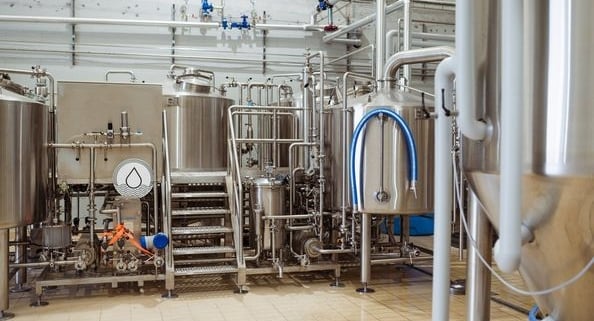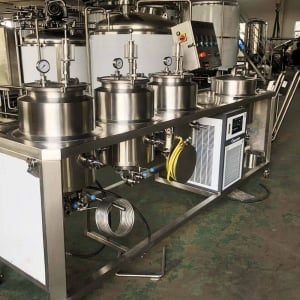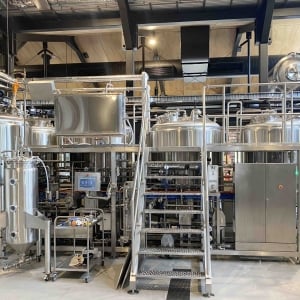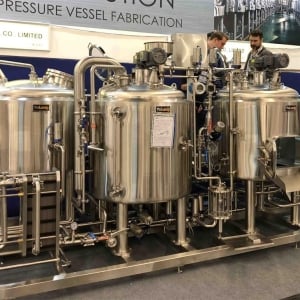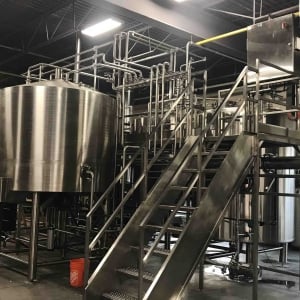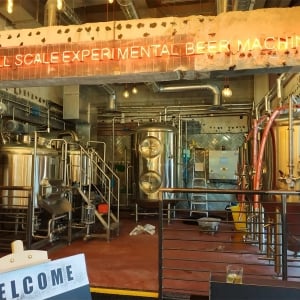Understanding 3 BBL Brewing Systems
Significance of 3 BBL Brewing Equipment
Understanding 3 BBL Brewing Systems
A 3 BBL (Barrels per Batch) brewing system is a popular choice among small to medium-sized breweries. This system comprises several key components, each vital to the brewing process:
Mash Tun
- Function: Where grains are mixed and heated with water, converting starches into fermentable sugars.
- Importance: Ensures efficient mashing and optimal extraction of sugars.
Lauter Tun
- Function: Separates wort (sweet liquid) from spent grains.
- Importance: Maximizes sugar extraction, minimizes waste.
Boil Kettle
- Function: Boils wort, sterilizes it, and allows for hop addition.
- Importance: Ensures efficient boiling and precise temperature control.
Fermentation Vessels
- Function: Where yeast ferments the wort into beer.
- Importance: Crucial for optimal fermentation and consistent beer quality.
Cooling and Glycol Systems
- Function: Maintains proper fermentation temperatures.
- Importance: Ensures consistent, high-quality beer.
Control Systems
- Function: Monitors and controls brewing parameters.
- Importance: Ensures consistency and quality in every batch1.
Advantages of a 3 BBL Brewing System
- Scalability: Ideal for transitioning from homebrewing or expanding brewing capacity without significant investment in larger equipment or additional space.
- Customization: Tailor the system to specific brewing needs and preferences.
- Cost-effectiveness: Lower initial investment compared to larger systems, making it an attractive option for startups or expansion of existing operations.
Role in Microbreweries
In microbreweries, the choice of equipment significantly impacts the brewing process, product quality, and overall success. Selecting appropriate equipment like a 3 BBL brewing system ensures efficiency, maintains quality and flavor, and minimizes maintenance costs and downtime.

Cost Analysis of 3 BBL Brewing Equipment
Overview of 3 BBL Brewing System Costs
The cost of a 3 BBL (Barrels per Batch) brewing system varies significantly based on various factors, including the specific components, the quality of materials, and additional features. A comprehensive understanding of the associated costs is essential for anyone considering investing in such a system.
Initial Investment and Component Costs
- Initial Setup Cost: Setting up a 3 BBL brewing system requires a substantial initial investment. The cost for the basic brewing equipment starts around $50,000 to $60,000. This price range may vary based on the specific features and quality of the equipment1.
- Component Breakdown:
- Mash Tun: Necessary for mashing process, affecting efficiency and sugar extraction.
- Lauter Tun: Used for separating wort from grains, important for maximizing sugar extraction and minimizing waste.
- Boil Kettle: Boils wort and allows for hop addition, crucial for efficient boiling and temperature control.
- Fermentation Vessels: Houses yeast for fermenting the wort into beer, vital for fermentation quality.
- Cooling and Glycol Systems: Maintains fermentation temperatures, ensuring consistent beer quality.
- Control Systems: Monitors and controls brewing parameters, key for batch consistency and quality.
Operational Costs
- Ingredient Costs: For a 3 BBL batch, the main cost is the grain, approximately 50lbs of malt. Hops, especially pellet hops, and quality liquid yeast also contribute to the cost, totaling around $100 per 3 BBL batch, excluding packaging costs.
Comparison with Larger Systems
- Larger Systems Cost: For context, a 10 BBL brewhouse can cost between $65,000 to $85,000, indicating the significant price difference with larger capacity systems.
Additional Considerations
- Licensing and Equipment: Besides the brewing equipment, obtaining a license and purchasing necessary commercial brewing equipment can range from $100,000 to $1 million, depending on the brewery size.
- Facility Size: The cost of operating a brewhouse varies greatly based on the size and shape of the facility, impacting the overall investment.
Types of 3 BBL Brewing Equipment
In a 3 BBL (Barrels per Batch) brewing system, various types of equipment play crucial roles. Understanding these components is essential for anyone interested in brewing craft beer at this scale.
Key Components of a 3 BBL Brewing System
1. Mash Tun
- Function: Where the mashing process occurs, mixing and heating grains with water.
- Importance: Ensures efficient mashing and optimal sugar extraction.
2. Lauter Tun
- Function: Separates sweet liquid (wort) from spent grains.
- Importance: Maximizes sugar extraction and minimizes waste.
3. Boil Kettle
- Function: Boils the wort, sterilizes it, and allows for hop addition.
- Importance: Ensures efficient boiling and precise temperature control.
4. Whirlpool
- Function: Separates hop matter, proteins, and other solids from the wort.
- Importance: Aids in transferring clear wort to fermentation tanks.
5. Fermentation Vessels
- Function: Houses yeast for fermenting the wort into beer.
- Importance: Crucial for optimal fermentation and consistent beer quality.
6. Cooling and Glycol Systems
- Function: Maintains proper fermentation temperatures.
- Importance: Ensures consistent, high-quality beer.
7. Control Systems
- Function: Monitors and controls brewing parameters.
- Importance: Ensures consistency and quality in every batch1.
Functions of 3 BBL Brewing Equipment
A 3 BBL brewing system, designed for microbreweries, encompasses various components, each serving distinct functions crucial for the brewing process. Understanding these components is vital for the success and efficiency of the brewing operation.
Essential Components and Their Functions
1. Mash Tun
- Function: Where mashing occurs, involving the mixing and heating of grains with water.
- Purpose: Facilitates the conversion of starches into fermentable sugars, crucial for the brewing process.
2. Lauter Tun
- Function: Separates the sweet liquid (wort) from the spent grains.
- Purpose: Features a false bottom to maximize sugar extraction and minimize grain waste.
3. Boil Kettle
- Function: Boils the wort and is where hops are added.
- Purpose: Sterilizes the wort, concentrates sugars, and extracts bitterness and aroma from hops.
4. Whirlpool
- Function: Separates hop matter, proteins, and other solids from the wort.
- Purpose: Creates a whirlpool effect to transfer clear wort to fermentation tanks efficiently.
5. Fermentation Vessels
- Function: Houses yeast for fermenting the wort into beer.
- Purpose: Ensures optimal fermentation and consistent beer quality.
6. Cooling and Glycol Systems
- Function: Maintains proper fermentation temperatures.
- Purpose: Ensures consistent, high-quality beer production.
7. Control Systems
- Function: Monitors and controls brewing parameters.
- Purpose: Tracks parameters like temperature, pressure, and flow rates for consistency and quality1.
Applications of 3 BBL Brewing Equipment
3 BBL brewing systems are versatile and serve various applications, especially in the craft brewing industry. Their functionality and capacity make them suitable for a range of settings and purposes.
Key Applications
1. Small to Medium-Sized Breweries
- Use Case: Ideal for breweries that are either starting up or expanding from homebrewing.
- Advantages: Offers scalability without significant investment in larger equipment or additional space.
- Customization: Allows tailoring to specific brewing needs and styles, enhancing the variety of beer produced.
2. Brewpubs and Restaurants
- Use Case: Commonly found in restaurants, pubs, and bars.
- Purpose: Used to produce craft beer for visitors and customers to drink on the premises.
- Benefits: Adds an element of uniqueness to the establishment, attracting customers interested in craft beer.
3. Craft Beer Production
- Use Case: Suited for producing a variety of beer styles in smaller quantities.
- Advantages: Enables small breweries or brewpubs to offer a diverse range of beers to their customers.
- Cost-Effectiveness: Despite the initial investment, the ability to produce a wide variety of beers can be a worthwhile investment.
Benefits of 3 BBL Brewing Equipment
The 3 BBL brewing system, particularly advantageous for small to medium-sized breweries, brewpubs, and bars, offers a myriad of benefits. These advantages cater to various needs, from business expansion to product diversity.
Key Benefits
1. Scalability for Business Growth
- Advantage: Ideal for breweries transitioning from smaller operations or expanding current capacity.
- Impact: Allows for increased production without significant investment in larger equipment or additional space, facilitating business growth.
2. Customization and Variety
- Advantage: The system can be tailored to specific brewing needs and styles.
- Impact: Enhances the variety of beer produced, catering to diverse customer preferences and creating a unique product lineup.
3. Cost-Effectiveness
- Advantage: More affordable compared to larger brewing systems.
- Impact: Lowers the barrier to entry for starting a microbrewery or expanding operations, making it financially accessible.
4. Ideal for First-Time Brewers and Medium-Volume Establishments
- Advantage: An excellent choice for first-time brewers or medium-volume breweries and bars.
- Impact: Provides an opportunity to test and refine beer recipes before scaling up, reducing risks associated with new product development.
5. Meeting the Demand for Unique Beers
- Advantage: Well-suited to produce unique, high-quality craft beers.
- Impact: Addresses the growing market demand for diverse and quality craft beers, enhancing the competitiveness of the brewery.
6. Practical for Testing and Recipe Trial-Runs
- Advantage: Perfect for experimenting with new beer recipes.
- Impact: Enables breweries to innovate and refine their beer offerings without disrupting their main production lines.
Choosing the Right 3 BBL Brewing Equipment
When selecting a 3 BBL brewing system, it’s crucial to make an informed decision based on several key factors. Here’s a guide to help you choose the right equipment for your brewing needs:
Considerations for Selecting a 3 BBL Brewhouse
1. Capacity
- Importance: Aligns with production goals and customer demand.
- Consideration: Decide based on your sales channels (kegs, cans, etc.) and the volume needed to meet demand.
2. Budget
- Importance: Crucial for financial planning and long-term sustainability.
- Consideration: Factor in not only the purchase cost but also long-term operational expenses like maintenance and energy efficiency.
3. Energy Efficiency
- Importance: Affects utility costs and environmental impact.
- Consideration: Choose equipment that balances energy efficiency with necessary brewing capabilities.
4. Brewing Process
- Importance: Ensures versatility for different beer types.
- Consideration: Opt for a system that accommodates various brewing techniques and ingredients.
5. Maintenance and Support
- Importance: Impacts the system’s longevity and performance.
- Consideration: Look for systems with strong warranty, technical support, and accessible parts and repairs.
Additional Factors to Consider
1. Space Requirements
- Importance: Determines the practicality of the system in your facility.
- Consideration: Ensure enough room for the system and associated equipment, along with adequate ventilation, drainage, and utility connections.
2. Quality and Manufacturer Support
- Importance: Ensures reliable operation and access to assistance.
- Consideration: Choose a reputable manufacturer known for high-quality equipment and excellent customer support.

